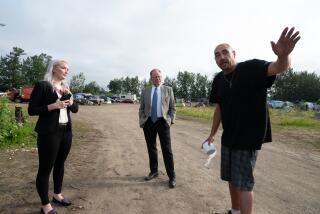Cold Fact: Arctic Housing Is Scarce
IQALUIT, Canada — To be homeless imposes a great indignity. To be homeless in the world’s harshest climate is frightening and potentially deadly.
In this Arctic community of 3,500, most of the 50 or so homeless people survive in unheated plywood shacks on the beach or sleep in the small public shelter until they are kicked out at 10 a.m. The others crowd in with relatives or friends.
Winter temperatures can drop to 40 below. With a little wind, the skin will freeze in seconds.
“I have spent more time on housing issues since I’ve been mayor than anything else,” Charlie Ruttan said.
“My dog lives better than they do,” he said of the 15 people from three families in the beach shacks. “They have run an extension cord across the beach from some other people’s house so they have a light. They heat and cook on a Coleman stove.
“These people are making less than $2,000 a month. There is no way they can ever get housing.”
While $2,000 a month might not sound bad, life is expensive in Canada’s Northwest Territories. A grilled cheese sandwich costs $7 in an Iqaluit restaurant; a liter of milk is $5.50.
“There are a lot of people tolerating overcrowded conditions, but it’s a terribly desperate way to live,” said Bill Riddell, a social worker in Iqaluit.
Housing is extremely expensive to build in the Canadian Arctic. Every board, nail, pipe and wire has to be shipped from the south. Nearly all housing is subsidized.
In Yellowknife, the territorial capital 1,400 miles to the west, homeless people can be found sleeping in the alcoves of automatic banking offices. The Mounties are usually tolerant.
There are not many homeless people in the Arctic: those in Iqaluit, a dozen or so in Yellowknife and smaller numbers in other communities.
There are so few because the Inuit, as the Eskimos prefer to be called, are a generous people who help one another. Refusing someone shelter above the Arctic Circle is not taken lightly.
One result is that much of the housing is overcrowded. A small, three-bedroom place may be packed with 14 or 15 people.
The Northwest Territories cover 1.3 million square miles, more than a third of Canada, but have a population of 54,000. Most of the territory is north of the tree line.
Officials of the Northwest Territories Housing Corp. estimate that 3,136 more housing units are needed now, but the corporation plans to build only 284 in 1992 and its budget is shrinking.
“Essentially, what is happening is pretty much the status quo,” said Jim Atkin, the corporation’s capital planner.
In 1991, the capital construction budget was $71.2 million. That dropped to $62.9 million in 1992 as the federal government cut spending because of the recession.
“It costs $220 a square foot to build housing in the north,” said Aziz Kheraj, a contractor in Resolute Bay. “That means a 1,000-square-foot home is going to cost you $220,000.”
Most people who work in the Arctic are public employees living in assigned government housing. Others are transients likely to leave in two or three years.
Public, or subsidized, housing is a way of life in the north.
In Pond Inlet, on the northern end of Baffin Island, 85% of permanent residents live in public housing. They pay about $125 a month in rent, which doesn’t even pay for electricity.
Kheraj, the contractor, said that the heating, electricity and water bills for his Resolute Bay home are $2,000 a month. He pays 34 cents per kilowatt hour for electricity; in Toronto, the rate is 7.2 cents.
Only after World War II did the Inuit moved out of houses made of snow, stones or animal skins and into southern-style frame houses.
More to Read
Sign up for Essential California
The most important California stories and recommendations in your inbox every morning.
You may occasionally receive promotional content from the Los Angeles Times.










